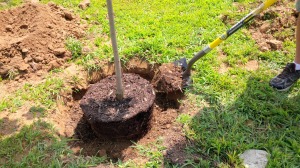Whether planting a beautiful maple, flowering dogwood – or an apple, cherry or peach tree – Fall is one of the best times to establish new trees in your landscape.
The cooler temperatures of autumn allow for less stress on newly planted trees – especially compared to planting during the Spring or Summer months – when fledgling trees can face soaring temperature swings and sweltering heat. It can also mean far less watering chores to get them established.
Fall planting allows for just enough time for the roots of a tree to become established – getting them accustomed to the soil and preparing them for fast growth the following year.
How To Plant: The Importance Of Digging The Hole
One of the most important parts of planting a tree is in the digging of the hole. The size of your planting hole should be dug to about two times the diameter of the container that your tree came in. Some people get nervous thinking that 2x’s the size of the container means digging a deep hole – but this only applies to the diameter.
As for that depth – you will want to dig the hole only about 4 to 6″ deeper than the root ball. You won’t be planting your tree that deep – but this allows for the loosening of the soil underneath so that your roots have plenty of room to expand.

An equal mix of compost and soil from the freshly dug hole is perfect for filling in around the tree
Once your hole is dug – mix back in equal amounts of compost and soil to the bottom of the hole, filling it up enough so that the top of the tree’s root ball will sit about and inch above the top of the hole. The mix of soil and compost will allow for better drainage and let the roots more easily expand into the soil around the tree – not to mention a little boost of nutrients from the compost.
Making sure that the tree is slightly above the soil line is an important step – if the tree’s crown is planted below – it can prevent drainage of excess water during heavy rains and result in a water-logged root ball.
Watering In The Tree
With the root ball in the hole at the proper depth – generously water the entire ball with 3 to 4 gallons of water, then fill in around the rest of the hole with equal amounts of compost and soil. When your tree is completely planted – you want the base of the trunk to be just above ground level – allowing for good drainage. Apply a 2 to 3″ layer of mulch (shredded hardwood mulch, straw, or shredded leaves work well) to help the tree retain moisture and protect the root ball from winter.

Fill in around the root ball with the soil-compost mix – make sure to keep the crown of the tree slightly above the soil level
You will want to keep watering you tree with about 3 to 5 gallons of water twice a week for the first 2 to 3 weeks after planting. After that – you will want to water at least once a week up til about the end of November. This of course, can be less if you are receiving the equivalent amount in rain. Either way – it is extremely important to keep your tree hydrated after planting – lack of water is one of the single biggest reasons newly planted trees fail.
Securing and Protecting Your Tree
Once your new tree is planted – you may want to take a few final steps to protect it from mother nature.

Learning a hard lesson from our first year – all of our orchard trees are now covered with deer fencing for the late fall and winter months to protect them from the deer.
We use metal T-Stakes and drive them in the ground about 6″ past the root ball zone – and then secure the tree to them with heavy jute rope and a piece of old rubber hose. By running the rope through the hose and using it around the trunk – you eliminate the worry of cutting into the tree with the rope as the tree grows or the wind blows.
If you are in an area with deer – you may also want to wrap your tree with some protective mesh or snow fencing during the late fall and winter months. Deer can destroy young saplings by rubbing their antlers on the bark – or chewing down low hanging branches – especially when there is little other food for them to find. Wrapping them for the first few years can help get your trees of to a great start and protect them until they are strong and big enough to sustain deer or wildlife damage.
If you would like to receive our DIY & Gardening Tips each week – be sure to sign up to follow the blog via email in the right hand column, “like” us on Facebook, or follow us on Twitter.
Happy Fall Planting!!! Jim and Mary – Old World Garden Farms

